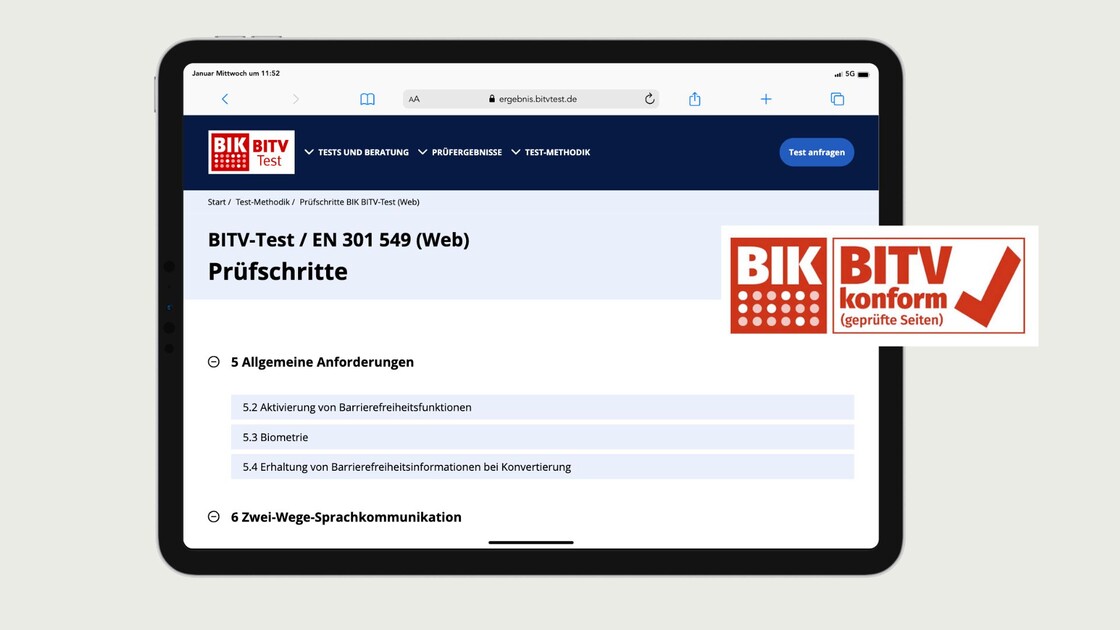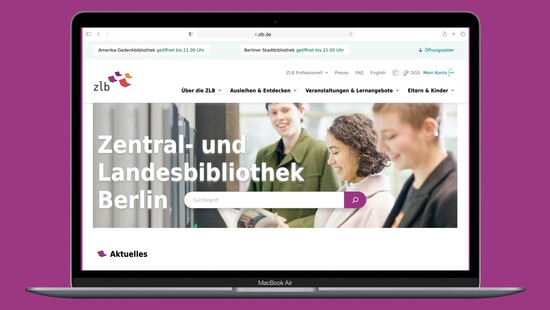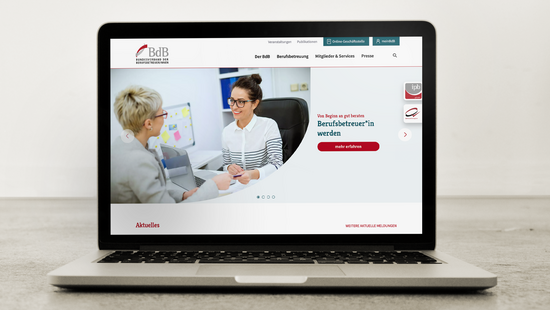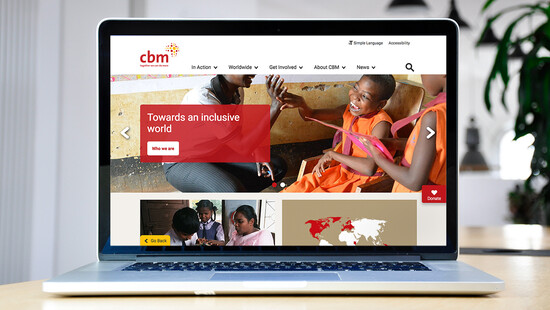BITV certification Accessibility with a seal of approval

"Information and services from public bodies that are provided electronically, as well as electronically supported administrative processes with and within the administration, including procedures for electronic file management and electronic processing, must be accessible and usable for people with disabilities."rdinance on the creation of barrier-free information technology in accordance with the Disability Discrimination Act (Barrier-free Information Technology Ordinance - BITV 2.0)
This is what the German Accessible Information Technology Ordinance, or BITV for short, stipulates. We therefore often read the requirement "Accessibility in accordance with BITV must be fulfilled" in website tenders or requests for quotations. Our first question is then: Is an external audit with certification required?
What is the point of the seal of approval?
When people start jogging to do something for their health, many immediately set themselves the goal of running a marathon. I feel the same way about accessibility with the BITV seal. You can be proud of it - but have you done the best for your health or the interests of people with disabilities?
The BITV does require content to be made accessible. However, there is no obligation to have this independently certified.
In short: You do not need a test seal to provide accessible content. However, this confirms that the website has fulfilled all accessibility test steps at the time of the test. The problem with this? No statement is made as to whether the website is still accessible after the test and therefore permanently usable for people with disabilities. But let's start from the beginning: What exactly does a BITV test consist of?
How does a BITV test work?
To assess whether an application or website is accessible, there is the official BITV test with 98 test steps. That sounds intimidating at first. However, many of the test steps are not applicable to standard websites (e.g. test steps for video chat functions) and can therefore be skipped.
For the remaining points, a representative selection of pages of the website to be tested is first created, for example the homepage, an area overview page, a page with a form and one or more article pages containing all possible content types (image galleries, tables, fold-out functions, lists, filters, etc.). For each of these pages, all steps are now checked and assessed as to whether they can be considered fulfilled or whether improvements are required. The greater the complexity of the website (more page and content types), the greater the effort required for the BITV test.
As the test steps are public, you can also carry out such a test yourself. However, a self-test naturally means that no seal is awarded if the test is passed. Anyone wishing to have the accessibility of their website officially confirmed must therefore commission an external test by specially trained service providers. Only then can you display a seal on your website and be included in the list of audited websites.
What does an external audit cost?
The central question is of course always: What does it cost in the end? When it comes to an external BITV test, we have to be honest and say that we cannot estimate this at the time of submitting the offer. As we cannot certify ourselves, we have to ask specialised service providers to examine the site to be tested, identify the pages to be tested and get a rough overview of how complex the website is. However, they can only do this once the website already exists, not at a time when the contract for its realisation has not even been awarded.
But isn't barrier-free realisation in the hands of the contractor anyway? This is only partly true. After all, an accessible website requires extensive support from the editorial team, for example in the correct labelling of content, the inclusion of alternative texts, the labelling of abbreviations and foreign-language text sections and the provision of subtitles or audio transcriptions of videos. As an agency, we are solely responsible for the technical framework and the creation of the possibilities for depositing the aforementioned labelling. The responsibility for passing a BITV test therefore lies equally with the client and the contractor.
It is therefore dubious to put a fixed price behind the item "External testing for BITV conformity". There are also no empirical values that can be referred to at this point, as just one more page type (determined by the person carrying out the test) can quickly result in four-figure additional costs. And these are only the costs for the test, the correction and customisation costs are not included.
As a ballpark figure, we can only say that you can expect costs of around €1,000 per page and test. The external audit of an average complex website is therefore usually in the five-figure range.
The path to an accessible website
These remarks are not intended to cast doubt on the fact that accessibility is a goal worth striving for. The only question is at what price and with what effort. To put it bluntly: The cheapest accessible website is a business card with static content - but this is equally uninteresting for people with and without impairments. This is certainly not the standard by which you want to measure yourself.
That's why we support our customers when they place a special focus on accessibility. Once the website has been completed and filled with editorial content, we recommend a self-test to determine the need for optimisation. This test is carried out by a person who was not involved in the project realisation in order to rule out operational blindness where possible. This step is also necessary for an external audit, otherwise you are guaranteed to fail.
We then regularly correct obvious or easy-to-fix problems as part of the project implementation. In the case of more complex adjustments, we work with our customers to agree on the extent to which the effort is justified or whether we should add to the accessibility statement that certain content is not accessible and what alternatives exist.
Aren't we making things too easy for ourselves?
Simply stating on the "Accessibility statement" page that a website is not accessible is not in the spirit of the BITV, nor is it our claim. Nevertheless, we cannot ignore economic realities. Optimising content for accessibility costs money and requires constant consideration.
As already described at the beginning, a test is only considered "passed" if all test steps have been fulfilled. Particularly in view of the fact that an external test for a test seal incurs high costs, it would be highly unsatisfactory to be satisfied with a "fail". As we know from the Pareto principle: the last little bit needed to pass accounts for the majority of the budget. The most cost-effective solution is therefore often to remove the offending content.
Ultimately, however, no one is helped by hiding content on the website just to pass a test. A (not entirely hypothetical) example: A customer produces videos in sign language for a deaf audience. However, as it would no longer be profitable to regularly provide a transcription for blind people (who are not the target group of this service), the entire service is cancelled and the videos are no longer produced.
The proposed procedure with self-testing instead of external testing, on the other hand, allows our customers to set priorities. They can use the requirements of the BITV to optimise their website and identify potential for improvement. Even if the website is not barrier-free in the sense of the BITV in the end, the greatest possible accessibility can be achieved, which is still economical for our customers.
So how important is the seal of approval in the end?
Nonetheless, accessibility remains a goal worth striving for. That's why we also advise and support our customers in their desire to acquire a seal of approval.
But it is important to bear in mind that such a seal of approval is currently only a snapshot; it indicates that all test steps have been passed at the time of the test, so to speak, that you have crossed the finish line of a marathon at the end of your strength.
However, if you are serious about accessibility, you cannot pat yourself on the back after reaching this goal line and simply tick the topic off, but must keep at it permanently to ensure that the website remains accessible even after certification.
In addition, although there are currently no legal consequences for a lack of accessibility, this could change in the future. In this case, the situation must of course be reassessed.
Our most accessible projects.


